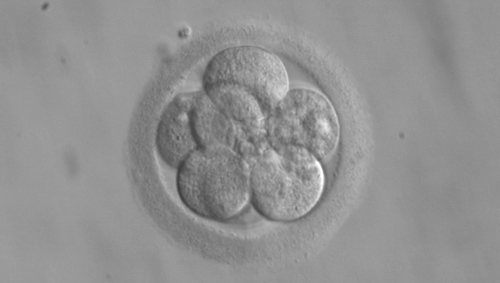
My wife and I have Type A blood, but our child has AB! How did this happen?
February 13, 2015

- Related Topics:
- Blood type,
- ABO blood type,
- Rare events,
- Chimera,
- Consumer genetic testing,
- Ancestry tests,
- Reproduction
A curious adult in California asks:
"My wife and I recently went to a fertility clinic and we are worried they may have implanted the wrong embryo. We both have an A blood type and our child has an AB blood type which I have read is impossible. How can we determine what is going on?"
We at Ask a Geneticist get hundreds of questions from people from all over the world each month. Occasionally we get one that leads to a longer journey of tests, follow up questions, and ultimate discovery. We have summarized and shared this couple’s story, as it may be helpful for other people to know.
As I initially told this couple: despite what you may have heard, it is not impossible for two parents with an A blood type to have a child with an AB blood type. It is very rare but like every other genetic rule, there are always exceptions.
Since all of these exceptions are exceedingly rare and not necessarily easy to test, it is a good idea to first figure out if the child is related to you. The best way to do this is with a DNA test. Then, if you can rule out the obvious (a mistake at the clinic, etc.), you can then consider the exotic (mutation, chimerism, etc.).
These days there are lots of DNA tests available to see if a man is the father of a child or not. Classic paternity tests can pretty much just tell you if a man is likely to be the father or not. Ancestry-type tests are more powerful; they can also tell how related you are to the child if you're not the father.
As I found out later, it turned out to be a good thing the parents in this case chose the second kind of test.
The test results showed that the man shared 25% DNA with the child, instead of the 50% you would normally expect to see for a father and child.
If they had gone with a run of the mill paternity test, they would have missed that the man and the child were related. (Click here to learn more about how paternity tests work.)
Being 25% related is usually something you see for an uncle/aunt, niece/nephew, half sibling, or a grandparent and a grandchild. But none of these really made sense because the fertilized egg was directly implanted into the mother’s womb.
The most likely explanation here is that dad is a chimera. What that means is he started out as fraternal twins who fused when they were only a few cells big.

The resulting person, the father in this case, is made up of a set of cells from one twin and a set from the other. He has two sets of DNA!
What probably happened is that the sperm that fertilized the egg had the DNA of one twin and his cheek cells had the other twin’s DNA. So to the DNA test, the man looks like the child’s uncle even though he is the dad.
Again this would have been missed with a simpler, more standard paternity test. These tests are very good at seeing if two people share 50% of their DNA but are pretty awful at seeing if two people share 25% of their DNA.
A standard paternity test would have almost certainly come back showing that the two were unrelated even though they were. I shudder to think of the consequences.
Luckily it didn’t come to that. We could see that the two were related.
Most likely the “twin” carried the B version of the ABO gene so the child could have AB blood. This could happen even though the DNA tested in his cheek cells had no B version. Is genetics cool or what!
Their Test Results
For the test, the couple went with a company called 23andMe. It isn’t the only test out there (AncestryDNA is another one) but it is the one I know best.
The 23andMe test looks at hundreds of thousands or even a million different markers. This means the company can match whole segments of DNA instead of just looking at isolated bits of it. In essence they can compare huge regions of each chromosome and look for matches.
Here is what the test results looked like:

In this picture the man’s DNA and the child’s DNA are being compared chromosome by chromosome. The numbers on the left are chromosomes numbers. The green line represents the shared DNA. So, for example, these two happen to share a lot more of chromosome 1 than they do of chromosome 22 and so there is a longer green line on chromosome 1.
If the two shared 50% of their DNA like the average father/child, then each chromosome would have an unbroken green line. In other words, they would share one whole chromosome from each chromosome pair. (Remember we have 23 pairs of chromosomes. One from each pair comes from mom and the other from dad.)
But in this case, just part of one chromosome came from “dad.” As I said earlier, this kind of result is more like an uncle and a niece or nephew than it is a father and child. Which is why, given that the child was conceived in a fertility clinic, it is most likely that the father is a chimera.
Chimeras
Chimeras are really fraternal twins who fused together very early in development. The fusion happens early enough that there aren't any issues with being conjoined or having extra limbs or anything. A chimera is simply a single person made up of cells from two siblings.

Sometimes there are outward signs of being a chimera. They might have the hair on one side of their head that is a different color than the other side. Or they might have two different colored eyes. Or maybe stripes that can only be seen under ultraviolet light. (Though there are also other explanations for each of these.)
Often, though, there are no signs. Someone might be a chimera and not even know it! Until something like this situation happens.
It is very unlikely this man would ever have known he was a chimera if his child had been born with A blood type. He would have gone about his business unaware.
Unless of course he or his son needed an organ transplant, or had genetic counseling, or any of a number of other situations that involve a genetic test. Then, with the wrong test, he would have seen that he and his son were not related and questions about the fertility lab would have (re)surfaced..
But here we had a happy ending. He gets to be an uncle and a dad to his child.
Again, a standard paternity test would almost certainly have missed this. If the parents knew beforehand that something like this was possible, they could have asked the testing company for a more detailed test. But since they didn’t know, they would not have received such a test.

Author: Dr. D. Barry Starr
Barry served as The Tech Geneticist from 2002-2018. He founded Ask-a-Geneticist, answered thousands of questions submitted by people from all around the world, and oversaw and edited all articles published during his tenure. AAG is part of the Stanford at The Tech program, which brings Stanford scientists to The Tech to answer questions for this site, as well as to run science activities with visitors at The Tech Interactive in downtown San Jose.
 Skip Navigation
Skip Navigation
